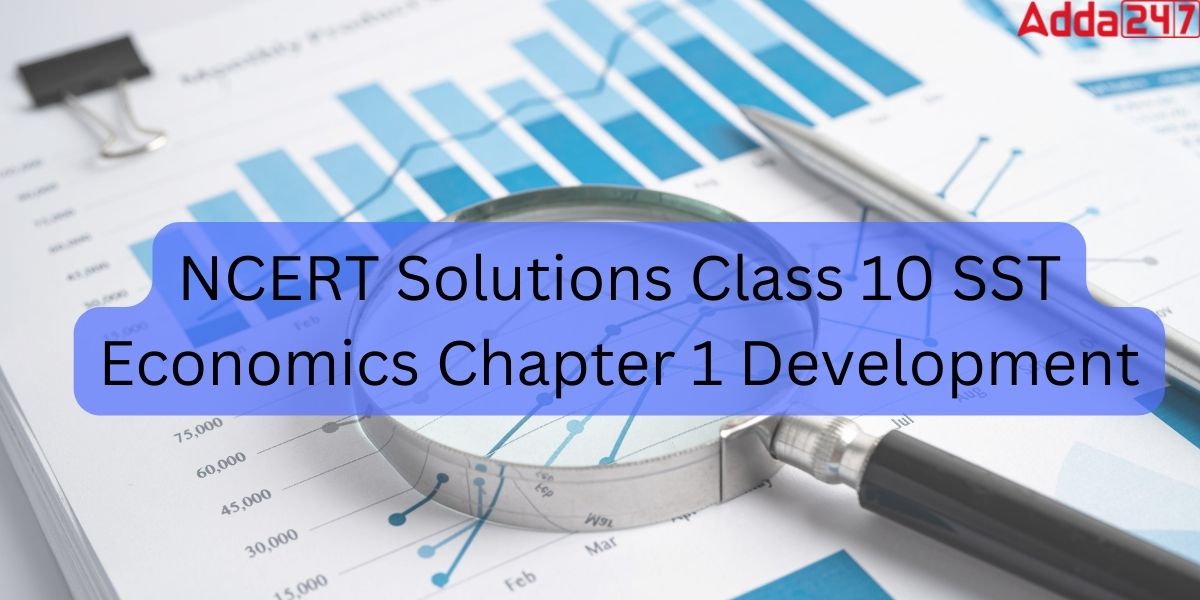Chapter 1 of the NCERT Solutions for Class 10 Social Science Economics offers a comprehensive understanding of the economic development that occurs in our economy. People and growth have long been associated with each other. They have goals or wishes for the kind of work and lifestyle they would like to lead. In a similar way, opinions regarding idealised national characteristics abound. Students will learn about the many facets of development that a nation requires in this chapter. In this article, we will explore the notes and take a look at the solutions of this chapter.
Adda247 Expert faculty team prepared NCERT Solutions Class 10 SST Economics Chapter 1 Development exercises of that chapter for a better grasp of the topics. These NCERT Solutions answer all questions in an easy and simple manner. These solutions will help you understand the concepts covered in the chapter completely. By writing these answers in the exam, students will undoubtedly be able to achieve high scores. Keep learning with Adda247.
Read: NCERT Solutions Class 10 SST Economics Chapter 1 Development
NCERT Solutions Class 10 Social Science Economics Chapter 1 Development Notes PDF
NCERT Solutions Class 10 SST Economics Chapter 1 Development is given in pdf format so students can easily download it for future use. Click here to download NCERT Solutions Class 10 SST Economics Chapter 1 Development
Class 10 SST Economics Chapter 1 Development Summary
NCERT Solutions Class 10 SST Economics Chapter 1 Development: Students will learn about the concept of economic development in Class 10 SST Economics Chapter 1. Let’s take a tour of the topics and subtopics which are included in the Class 10 SST Economics Chapter 1 Development.
- What development promises – Different people have different goals of development
- Concept of PPP – Purchasing power parity
- Perspectives on development
- Common indicators and methods of measuring development
- Income and other goals – this will talk about high salary, job securities, etc.
- National development – the ability of a nation to improve the standard of living of its citizens. This includes per capita income, Gross domestic products, literacy rates, etc.
- Comparison of different countries or states on the basis of per capita income and not national income, because each country has a different population rate.
- Calculation of per capita income.
- Income and other criteria.
- Public facilities.
- Sustainable development.
Class 10 SST Economics Chapter 1 Development Video Explanation
NCERT Solutions Class 10 Social Science Economics Chapter 1 Development Question and Answers
1. The development of a country can generally be determined by
- its per capita income
- its average literacy level
- health status of its people
- all the above
Answer: d. all the above
2. Which of the following neighboring countries has better performance in terms of human development than India?
- Bangladesh
- Sri Lanka
- Nepal
- Pakistan
Answer: b. Sri Lanka
3. Assume there are four families in a country. The average per capita income of these families is Rs 5000. If the income of three families is Rs 4000, Rs 7000 and Rs 3000 respectively, what is the income of the fourth family?
- Rs 7500
- Rs 3000
- Rs 2000
- Rs 6000
Answer: d. Rs 6000
Solution: (4000+7000+3000+x) ÷ 4 = 5000
14000+x = 5000 × 4
x = 20000-14000
x = 6000
4. What is the main criterion used by the World Bank in classifying different countries? What are the limitations of this criterion, if any?
Answer: The World Bank categorizes various nations based on their per capita income. By dividing the nation’s total income by its population, the per capita income is determined. The following categories are used to classify countries according to the WDR 2006 as of 2004:
- Rich countries are those with per capita incomes of at least $4,53,000. per year
- Low-income nations are those with per capita incomes of $37,000 or less.
The criterion has the following drawbacks:
- It is not clear how this income is dispersed throughout the population. A nation might have a more balanced distribution. Both immensely wealthy and extremely impoverished people are possible.
- One person may be enormously wealthy while others may be quite poor in a different country with the same average income. Therefore, using the method of average income does not accurately represent a country.
5. In what respects is the criterion used by the UNDP for measuring development different from the one used by the World Bank?
Answer. The World Bank uses a different criterion than the UNDP does. The Human Development Index used by UNDP is superior since it is a broader statistic that takes into account not only per capita income but also health and education. Contrast this approach with that of the World Bank, which measures development solely through the calculation of per capita income.
6. Why do we use averages? Are there any limitations to their use? Illustrate with your own examples related to development.
Answer: The population varies significantly between nations. We use averages because they provide an average when comparing different quantities of the same category. This does not represent how items are distributed among individuals. Average calculations have limits since we are unable to distinguish between individual people’s income levels and unequal income distribution throughout a nation or state. For instance, the distribution of income is not shown by per capita income. The percentage of the population who are poor is not displayed.
7. Kerala, with lower per capita income has a better human development ranking than Haryana. Hence, per capita income is not a useful criterion at all and should not be used to compare states. Do you agree? Discuss.
Answer: Kerala has a higher ranking for human development than Haryana despite having a lower per capita GDP. hence, I do not, agree with the claim that per capita income is not at all a valid criterion. Even if it is not the only factor and has limitations, per capita income is nonetheless beneficial in some cases. because characteristics like income, education level, and health status are combined to produce human development rankings. However, as it is one of the variables used to determine development, per capita income cannot be disregarded.
8. Find out the present sources of energy that are used by the people in India. What could be the other possibilities fifty years from now?
Answer. In India, people currently use firewood, coal, petroleum, crude oil, and natural gas as their energy sources. Other possibilities in fifty years might be ethanol, biodiesel, nuclear power, and greater wind energy use, particularly This is due to the potential loss of these resources for upcoming generations due to current energy usage.
9. Why is the issue of sustainability is important for development?
Answer. Sustainable development satisfies existing requirements without sacrificing the capacity of future generations to satisfy their own needs. The tremendous industrialization of the world during the past century has given rise to the problem of sustainable development. It is believed that industrialization and economic progress have resulted in the heedless exploitation of natural resources. However, there are only so many natural resources available. Development depends on the question of sustainability because if natural resources are not exploited wisely, they might not be accessible to future generations. Resources that are being depleted in a nation may ultimately prevent that nation from developing.
10. “The Earth has enough resources to meet the need of all but not enough to satisfy the greed of even one person.” How is this statement relevant to the discussion of development? Discuss.
Answer. The statement “The Earth has enough resources to meet the needs of all but not enough to satisfy the greed of even one person” is entirely applicable when discussing the development of a nation because resources and development are linked. The availability of resources for a country’s citizens to use is as important to development as the economic factors that influence it. The conservation of resources is essential for development to be sustainable. If not used carefully, all natural resources are non-renewable and will eventually run out. Therefore, it is the people’s responsibility to only use them to fulfill their requirements, not satisfy their greed.
11. List a few examples of environmental degradation that you may have observed around you.
Answer: Here are a few examples of environmental degradation we can see all around us:
- As a result of industries and vehicles emitting more smoke, air pollution has increased.
- Water pollution is increasing day by day..
- Deforestation, as a result of soil erosion and an unsatisfactory environment
- Excessive usage of groundwater decrease in groundwater level
- The usage of loudspeakers at night and unnecessary horns blowing on the roadways by various cars are responsible for noise pollution.
12. For each of the items given in Table 1.6, find out which country is at the top and which is at the bottom.
| TABLE 1.6 SOME DATA REGARDING INDIA AND ITS NEIGHBOURS FOR 2017 | ||||
| Country | Gross National income (GNI) per capita (2011 PPP US$) |
Life Expectancy at birth (2017 |
Mean Years of Schooling of People aged 25 and above (2017) |
HDI rank in the World (2018) |
| Sri Lanka India Myanmar Pakistan Nepal Bangladesh |
11,326 6,353 5,567 5,331 2,471 3,677 |
75.5 68.8 66.7 66.6 70.6 72.8 |
10.9 6.4 4.9 5.2 4.9 5.8 |
76 130 148 150 149 136 |
Answer: Table 1.6 shows that I) Sri Lanka has the highest per capita income in the world, followed by Myanmar (ii) Myanmar has the lowest life expectancy at birth, while Sri Lanka has the highest (iii) Sri Lanka has the highest literacy rate for people aged 15 and older, while Bangladesh has the lowest rate (iv) Country with the highest gross enrollment ratio is Sri Lanka; the lowest is Pakistan (v) Sri Lanka is ranked first in the world according to the HDI, whereas Nepal is last.
13. The following table shows the proportion of adults (aged 15-49 years) whose BMI is below normal (BMI <18.5 kg/m2) in India. It is based on a survey of various states for the year 2015-16. Look at the table and answer the following questions.
| State | Male | Female |
| Kerala
Karnataka Madhya Pradesh |
8.5
17 28 |
10
21 28 |
| All States | 20 | 23 |
A.Compare the nutritional level of people in Kerala and Madhya Pradesh.
Kerala’s population has a greater nutritional level than Madhya Pradesh’s population, both male and female.
B. Can you guess why around one-fifth of people in the country are undernourished even though it is argued that there is enough food in the country? Describe in your own words.
Despite the fact that there is enough food available, 40% of the population is undernourished. The major reasons are
- A significant portion of the population is so underprivileged that they cannot purchase nourishing food.
- Poor individuals in most states cannot obtain affordable food because the Public
- The distribution System (PDS) does not operate as intended.
- People with low educational levels experience unemployment as a result, which prevents them from purchasing food, a basic necessity.
NCERT Solutions Class 10 Social Science Economics Chapter 1 Development In-text Questions
Here we have provided some important questions that can be framed from the in-text notes of chapter 1 Development for Social Science class 10 Economics.
Q. What is meant by the term Development? Does everyone benefit from it?
Solution: Development is a process that guarantees everyone has a high quality of life in terms of contentment, harmony, and meeting their basic needs. It has to do with people’s goals, advancement, and betterment. All facets of society would profit from this definition of development since it emphasizes the concept of basic needs. As long as fundamental needs like food, shelter, healthcare, and education are met, more individuals will be able to make meaningful decisions.
The earlier ideas of development, which were solely focused on economic expansion, did not help the environment or the impoverished; instead, they led to an unbalanced ecology and a large divide between the rich and the poor. Therefore, the essence of development would be justified by a definition that strives to improve people’s quality of life.
Q. How is Sustainability and Development Related?
Solution: Using natural resources in a way that allows for their continued use by both current and future generations is known as sustainable development. Sustainable development is the need of the hour as it ensures that the resources are available for future generations. Because natural resources would not be available for future generations if they are not exploited responsibly, sustainability is a crucial concern for development. A nation’s inability to progress may eventually be caused by the depletion of its resources.
Found this article helpful?
Let’s connect via chat or call our senior expert counselor at +91-9625869989 to learn more about the different streams and options available. We would love it if we could add some of your insights. If you have a definite goal of scoring the highest marks, then you can resolve your doubts via our app (https://play.google.com/store/apps/details?id=com.adda247.app&referrer=invite_code=8973023) and youtube class assistance (https://www.youtube.com/c/Adda247School)
NCERT Solutions Class 10 SST Economics Chapter 1 Development- FAQs
Q. What is the development definition in Class 10 Economics Chapter 1?
A broad definition of development includes raising real per capita income, raising people’s standards of living, and lowering rates of illiteracy, poverty, and crime, among other things.
Q. How do I acquire the NCERT Solutions for Class 10 SST Economics Chapter 1 in an online PDF format?
Ans. you can download the NCERT Solutions for Class 10 SST Economics Chapter 1 PDF from the link provided in the article.
Q. How can using NCERT Solutions for Adda247’s Economics Chapter 1 for Class 10 SST benefit you?
Ans. The following are some benefits of using Adda247’s NCERT Solutions for Class 10 SST Economics:
- Students are given both the NCERT solution and a video explanation.
- A PDF is also provided, which can be downloaded and saved for future use.











 AILET 2026 AIR 1: Check Full Toppers Lis...
AILET 2026 AIR 1: Check Full Toppers Lis...
 AILET Result 2026 OUT, How to Download S...
AILET Result 2026 OUT, How to Download S...
 CUET PG Crash Course 2026: Subject-Wise ...
CUET PG Crash Course 2026: Subject-Wise ...














